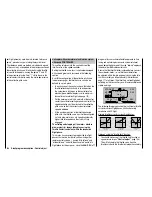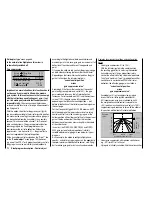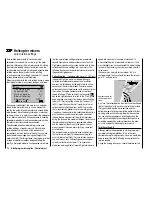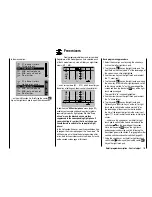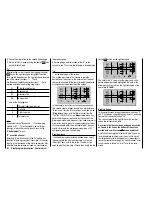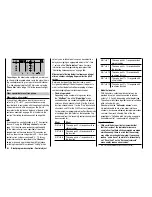
171
Detail program description - Control adjust
rotor defl ection. Set the mixer value so that there is no
fall-off in system rotational speed.
Roll
Throttle and Nick
Throttle
C1
Tail
Tail
0%
Roll
0%
Throttle
Throttle
SEL
Roll
Tail
Nick
Throttle
0%
0%
Nor mal
Increasing collective pitch is not the only change that
requires the throttle to follow suit: major cyclic control
movements also require this, i. e. if the swashplate is
tilted in any direction. The
mx-20
HoTT program lets
you adjust the degree of throttle follow separately for roll
and pitch-axis controls.
This offers particular advantages in aerobatic fl ying, e. g.
when fl ying a roll: here, with moderate collective pitch
values and the carburetor only about half-open, cyclic
control travels are nonetheless executed that require
much higher performance from the motor.
The mixer value can be varied within the range 0 to
+100%. The correct mixer direction is automatically
taken into account.
If you tap the
or
keys on the right touch
pad (
CLEAR
) at the same time, this will reset values
changed in the active (highlighted) fi eld back to 0%.
In the auto-rotation fl ight phase this mixer is
automatically switched off.
Tail rotor
throttle
C1
C1
Pitch
Throttle
Tail
Tail
0%
Roll
0%
Throttle
Throttle
SEL
Nor mal
While the tail rotor normally compensates for the effect
of main rotor torque on the fuselage, it is also used to
control the helicopter around the vertical axis. Increasing
tail rotor thrust requires a corresponding adjustment
to motor power, however, to avoid a fall-off in system
rotational speed.
This mixer sets the extent to which the throttle follows
the tail rotor. The throttle will follow on one side only,
to the side on which the tail rotor thrust is increased.
Values in the range 0% to +100% are therefore possible.
The direction depends on the main rotor's direction of
rotation (left or right), and this must fi rst be set correctly
on the "
Helicopter type
" menu. For left-hand rotation
systems, the throttle follows the tail rotor when the tail
rotor joystick is moved to the left, and vice versa for
right-hand rotation systems.
If you tap the
or
keys on the right touch
pad (
CLEAR
) at the same time, this will reset values
changed in the active (highlighted) fi eld back to 0%.
In the auto-rotation fl ight phase this mixer is
automatically switched off.
Set-up notes:
To set the mixer value accurately you should either fi rst
fl y several high-speed pirouettes against the direction of
main rotor rotation or, if a strong wind is blowing, hover
at right angles to the wind with a suffi ciently large tail
Roll
Tail and Nick
Tail
0%
Roll
0%
Throttle
SEL
Roll
Tail
Nick
Throttle
0%
0%
0%
Nick
Tail
Gyro suppress
Nor mal
Increasing pitch is not the only change that requires a
corresponding torque compensation via the tail rotor:
major cyclic control movements also require this, e.g.
if the swashplate is tilted in any direction. Here, too,
the
mx-20
HoTT program lets you confi gure settings
for both types of tilt movement (roll and pitch-axis)
separately.
For advanced aerobatics in particular, which involve
very large control defl ections in the pitch-axis
controls, e. g. the "Bo-turn" (vertical pull-up followed
by tipping over around the pitch-axis) and tight loops,
the uncompensated torque present in these fl ights
causes the model to turn to a greater or lesser degree
around the yaw axis. This spoils the appearance of the
maneuver.
These two mixers permit static torque compensation to
be activated by the swashplate tilting in any direction.
The mixers work by always increasing tail rotor thrust,
starting from the center point of the roll and pitch-axis
sticks, i.e. they always generate a tail rotor defl ection
in the same direction regardless of the direction of the
command.
The mixer value can be varied within the range 0 to
+100%.
The mixer direction is determined automatically by your
defi nition of the direction of main rotor rotation on the
Summary of Contents for mx-20 Hott
Page 41: ...41 Your notes...
Page 49: ...49 Your notes...
Page 55: ...55 Your notes...
Page 81: ...81 Your notes...
Page 85: ...85 Your notes...
Page 89: ...89 Your notes...
Page 99: ...99 Detail program description Control adjust...
Page 127: ...127 Detail program description Control adjust...
Page 131: ...131 Detail program description Control adjust...
Page 163: ...163 Detail program description Control adjust...
Page 191: ...191 Detail program description Control adjust...
Page 207: ...207 Detail program description Control adjust...
Page 228: ...228 Detail program description Control adjust...
Page 229: ...229 Detail program description Control adjust...
Page 251: ...251 Detail program description Control adjust...












